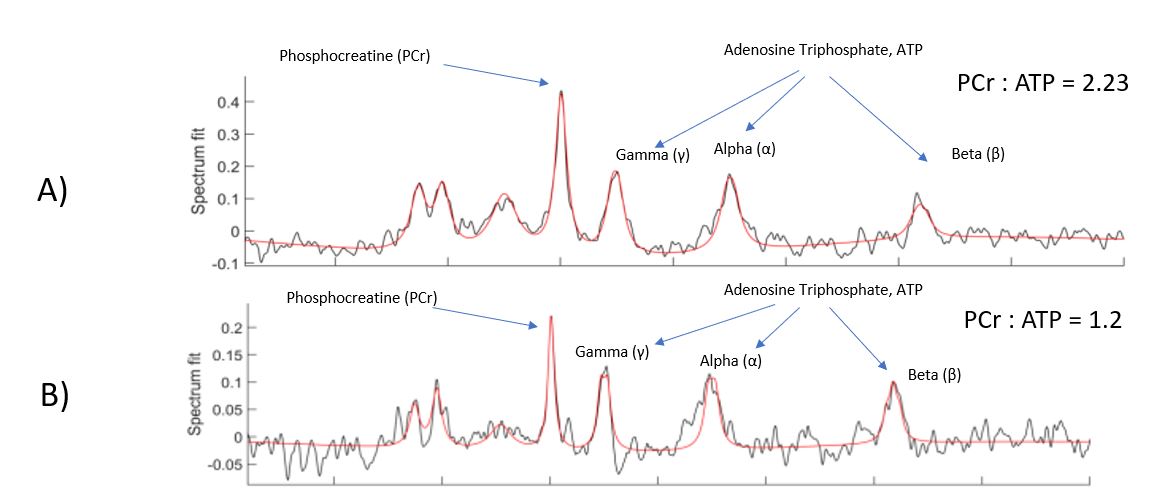Session Information
Session Type: Poster Session B
Session Time: 10:30AM-12:30PM
Background/Purpose: Primary cardiac involvement in systemic sclerosis (SSc) is heterogenous, poorly defined and associated with significant cardiac morbidity and mortality. The underlying mechanism is not well understood but may include the impact of coronary microvascular dysfunction and myocardial inflammation. Myocardial cellular metabolic alterations in SSc are yet to be established. Using 31 Phosphorous magnetic resonance spectroscopy (31 P MRS) and cardiovascular magnetic resonance (CMR), we aimed to establish if myocardial energetics, measured as phosphocreatine (PCr) /ATP ratio and quantitative myocardial perfusion were reduced in individuals with SSc compared to healthy volunteers (HV).
Methods: A total of 34 age and sex matched participants were recruited (24 SSc, 10 HV). All subjects underwent 31 P MRS and comprehensive CMR protocol including volumetric analysis, quantitative myocardial perfusion and T1 mapping. The European Scleroderma Trials and Research group (EUSTAR) activity index of ≥2.5 defined active SSc. Abnormal myocardial energetics was defined as PCr/ATP ratio (< 2).
Results: Table-1 shows clinical and CMR / 31 P MRS data. Left ventricular volume, bi-ventricular systolic function and left atrial function were similar in all groups. NT-Pro BNP and myocardial extra cellular volume (ECV) were increased in SSc, whilst both PCr/ATP and myocardial perfusion reserve (MPR) were significantly reduced in SSc compared with controls.
Presence of active digital ulcers correlated with reduced right ventricular ejection fraction (RVEF) (R = -0.537, P = 0.01), whilst global left ventricular longitudinal strain (GLS) correlated positively with PCr/ATP (R = 0.423, P = 0.04). The disease activity index did not correlate with either NT-pro BNP (P=0.79), PCr/ATP (P=0.35) or MPR (P =0.6). Active SSc had significantly lower RVEF than inactive SSc although it remained within the normal range. Presence of active digital ulcers correlated with reduced RVEF (R -0.537, P 0.0055), whilst GLS correlated positively with PCr/ATP (R 0.423, P = 0.04).
SSc patients with abnormal PCr/ATP were more likely to have interstitial lung disease (ILD) (42% vs 20%, p=0.29), less likely to a history of digital ulcers (33% vs 80%, p=0.03), and have reduced GLS (p=0.03).
Conclusion: In addition to validating our previous observations of reduced perfusion and increased myocardial fibrosis in SSc, we have demonstrated for the first-time significant reductions in myocardial energetics in patients with SSc. There was no difference in perfusion and energetics between active and inactive SSc but there were clinical differences in patients with abnormal energetics that need further validation. These findings provide further valuable insight into the pathogenesis of primary myocardial disease in SSc.
Values are mean ±standard deviations or percentages. BMI, body mass index; BP, blood pressure; DU, digital ulceration; ILD, interstitial lung disease; PAH, pulmonary arterial hypertension; MMF, patients on mycophenolate; NT-Pro BNP, N-terminal pro b-type natriuretic peptide; SCL-70, topoisomerase I antibody; DAVIX index, digital artery volume index on MRI; BSA indicates body surface area; LV, Left ventricle; RV, right ventricle; LA, left atrium; LA EF, left atrial ejection fraction; LGE, late gadolinium enhancement; PCr, phosphocreatine; ATP, adenosine tri-phosphate; MBF, myocardial blood flow; MPR, myocardial perfusion reserve.
To cite this abstract in AMA style:
Soo C, Jex N, Di Donato S, Thornton L, Kakkar V, Bixio R, Tomoaia R, Anderton T, Lwin M, Kamani C, Chowdhary A, Procter H, Thirunavukarasu S, Kotha S, Giannoudi M, Levelt E, Plein S, Delgado F, Bissell L. Systemic Sclerosis Is Associated with Sub-Clinical Abnormalities in Myocardial Energetics, Perfusion and Increased Fibrosis [abstract]. Arthritis Rheumatol. 2024; 76 (suppl 9). https://acrabstracts.org/abstract/systemic-sclerosis-is-associated-with-sub-clinical-abnormalities-in-myocardial-energetics-perfusion-and-increased-fibrosis/. Accessed .« Back to ACR Convergence 2024
ACR Meeting Abstracts - https://acrabstracts.org/abstract/systemic-sclerosis-is-associated-with-sub-clinical-abnormalities-in-myocardial-energetics-perfusion-and-increased-fibrosis/



